ICYMI: Government-Controlled Health Insurance Systems Are Unaffordable
Today, the General Assembly’s Human Services Committee will consider legislation in a public hearing to study “a Husky single-payer universal health care program.”
But we already know that government-controlled health care systems, whether single-payer or state government public options, do not work and are unaffordable.
Similar systems have failed to deliver on their promises in states where they have been tried — and past proposals for a government-run system in Connecticut were estimated to increase health care costs and reduce access to care. In case you missed it, get the latest from Connecticut’s Health Care Future on why these systems do not work HERE and below.
UNAFFORDABLE COSTS: Washington’s public option was estimated to reduce premiums five to 10 percent lower than traditional plans on the exchange. In the first year of implementation, public option premiums were 11 percent higher than the lowest available silver plans. Some plans were up to 29 percent more expensive than private plans.
Two years after implemented, the public option costs had “not come down enough yet to make a real dent in affordability or in the rates of uninsured and underinsured” and “the policies haven’t yet achieved the kind of sweeping change that proponents had hoped” according to POLITICO. Many providers initially refused to accept the state government controlled public option due to its low reimbursement rates. Governor Jay Inslee signed legislation mandating the participation of providers in the state’s public option despite concerns it would increase costs for consumers with private plans.
Colorado also has failed to deliver greater affordability to consumers since its implementation in 2023. According to an 2024 FTI Consulting study, “non-CO Option plans were the lowest cost option for enrollees seeking out bronze and silver plans” and the vast majority of Colorado Option plans (97.8 percent) failed to reach the state government-controlled system’s 10 percent premium reduction target.
REDUCED ACCESS TO CARE: Washington’s hospitals are paying the price for the state’s public option failures, and some may face closure. Hospitals in the state are making it harder for patients to get timely care. Healthcare leaders have warned that the public option relies on tying reimbursement to Medicare rates, which don’t cover hospitals’ cost of providing care.
In Colorado, the public option also hurt competition in the marketplace, reducing access to quality health care. The average number of plans decreased by 37.7 percent across the majority of Colorado counties, with the 87.5 percent of counties experiencing a 75.5 percent reduction in the number of available plans. Consumers in the state were left with fewer choices than before the implementation of the CO Option and saw more insurers leaving the marketplace.
LOW ENROLLMENT: Washington’s public option has been plagued by low enrollment since its first year. Only 0.7 percentof Washington’s residents enrolled in a public option plan in 2024. Two years after implementation, five counties still did not have access to a Cascade Select plan.
Just one percent of people buying plans on the exchange in Washington chose public option plans in the year it debuted, with plans only available in 25 of 39 counties in the state. Even with an assumption that all enrollees on the state’s public option were previously uninsured, the program only reduced the state’s uninsured rate by 0.6 percent after two years of implementation.
Nevada failed to learn from Colorado and Washington’s mistakes and is the on a path to implement a state-government public option. Already, the Nevada Public Option is expected to have little impact on enrollment when it is implemented in 2026, according to a 2024 report by Lanhee J. Chen, Ph.D., Tom Church, and Daniel Heil.
CONSQUENCES FOR CONNECTICUT: A 2022 report from KNG Health Care Consulting analyzing a past proposal to create a public option in Connecticut found that it could lead to higher taxes, higher premiums and reduced access to quality care.
The report found that existing state revenue from premium taxes and health insurance assessments could fall significantly under current rates – between $71 million and $122 million by 2023 – likely requiring the state to increase taxes. Premiums could also increase for workers and their families, including for those whose employers do not take up the public option. In addition, the number of uninsured individuals under the new public option could increase, depending on the rate of “take up” among employers.
In addition, the study estimated that provider reimbursement rates would likely have to be cut by 15 percent. This could negatively impact Connecticut residents’ access to the quality care they need. If the state did not reduce provider reimbursement rates, the state would likely have to collect between $816 million to $1.152 billion to replace lost tax revenue and secure financial footing.
Policymakers should continue to build on positive progress toward expanding access to affordable high-quality care by focusing on solutions that strengthen Connecticut’s current health care system instead of creating a one-sized fits all governmental-controlled program that will threaten access to affordable, high-quality care in the state.
Read more HERE.
